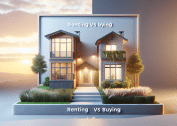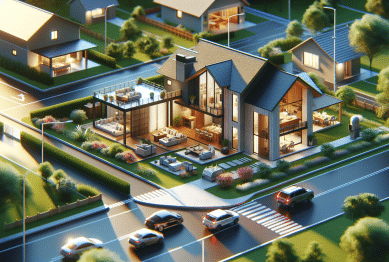When buying or selling a property, discovering what really drives home value can make all the difference. This guide explores surprising elements that influence prices and why understanding them matters for anyone navigating the modern real estate market.
Neighborhood Trends That Quietly Shape Home Worth
Property values are deeply influenced by neighborhood trends. These can be subtle, evolving over years rather than months, and play a significant role in determining how much a home is worth. Factors like local schools, parks, and even new businesses change how people perceive an area. For instance, a neighborhood gaining a popular grocery or improved public transportation can see property value increase unexpectedly. Research consistently points to the importance of these community shifts when evaluating any real estate asset (Source: huduser.gov).
Sometimes, neighborhood reputation is shaped by historical patterns or prior redevelopment efforts. A district once overlooked may suddenly become a cultural hotspot due to new dining or entertainment options. This transition doesn’t happen overnight. Buyers and sellers who monitor these signals closely can spot opportunities for rapid price appreciation ahead of the general market trend. Savvy investors often look to local government plans, such as rezoning or public amenities upgrades, as early clues.
Beyond amenities, safety and cleanliness also make a difference. A reduction in crime rates or an enhanced community watch program can contribute to increased demand. Data shows that homes within walkable, active neighborhoods tend to command higher prices even if the properties themselves are similar to those in less vibrant areas. The interplay between these local forces and perceived value is a key element of real estate analysis. brookings.edu
The Impact of Environmental Factors on Property Pricing
Environmental risks are now at the forefront of property valuation. Flood zones, proximity to wildfires, and even soil quality all feed into how much someone will pay for a home. What many overlook is that insurance premiums and long-term maintenance costs often tie back to these invisible risks. For example, houses outside a high-risk flood area may command a premium simply for being perceived as safer. These patterns are increasingly important as buyers use online tools to analyze potential hazards before they even set up a viewing (Source: epa.gov).
Noise pollution, air quality, and access to green space also influence residential satisfaction. Living near busy highways can decrease appeal, while adjacency to parks can increase it. These details subtly affect daily life but are reflected in home sale prices. Increasingly, municipalities are making efforts to improve environmental conditions, recognizing that healthier environments attract buyers who are willing to invest more in their homes. Thus, small ecological investments can yield major returns for neighborhoods.
Climate resilience has become a strong feature for modern buyers. Properties updated to withstand storms or that use sustainable materials tend to attract attention in listings. This effect is amplified in regions prone to weather extremes. Evidence suggests that the perceived value of a property rises when clear, eco-friendly upgrades and certifications are present. This trend highlights the growing intersection of environmental science and real estate marketing. (Source: energy.gov)
Renovations and Upgrades With Unexpected Influence
Not all home improvements offer the same boost to sales price. While a kitchen remodel remains a popular choice, energy-efficient add-ons like solar panels and enhanced insulation are increasingly significant. These upgrades not only cut utility costs but also appeal to eco-conscious buyers. In many markets, a modernized HVAC system or new windows gets more attention than aesthetic tweaks alone. Homeowners contemplating renovations benefit from researching which upgrades truly shift buyer interest. (Source: nahb.org)
Smart home technology, such as integrated security systems or energy management apps, is moving from luxury status to expectation. These features can differentiate a property even in crowded listings. Younger homebuyers, especially, value the convenience of automation and are willing to pay a premium for plug-and-play capability. This is particularly apparent in urban settings where tech-savvy buyers actively seek such functionality.
Surprisingly, certain renovations can have little to no positive effect or may even hurt resale value. Overly customized decor, niche landscaping, or additions that reduce usable outdoor space can be off-putting. It’s vital to weigh personal preferences against broad market trends if maximizing return on investment is the goal. Neutral, functional improvements generally outperform those based on individual taste.
Economic Cycles and Their Subtle Effects on Housing Markets
Broader economic conditions consistently influence housing prices. Interest rates, employment trends, and inflation all factor in. For example, when mortgage rates drop, more individuals can afford to borrow, which in turn drives up property demand and values. Conversely, economic downturns tend to reduce access to credit and slow the pace of home sales. The timing of a sale, therefore, can play a surprisingly large role in final price. Analyzing these cycles helps real estate participants plan strategically.
Local economies often diverge from national trends. Tech booms, for instance, can spark surges in selected urban neighborhoods while other areas lag behind. Evaluating regional data helps provide a sharper estimate of what’s next for home prices in a particular city or suburb. These small-scale economic forces sometimes lead to housing shortages, bidding wars, or conversely, excess inventory and falling prices.
Government intervention, in the form of tax incentives or development grants, also sways local property markets. Areas targeted for growing infrastructure or revitalization projects frequently see demand rise ahead of anticipated benefits. Understanding these micro- and macroeconomic effects is central to making sense of today’s fast-changing market landscape. (Source: nar.realtor)
Cultural Shifts and the Changing Definition of Home
Demographic trends and lifestyle preferences are quietly but powerfully shaping what buyers look for in a home. Remote work, for example, has prompted demand for home offices and greater privacy. Larger lots, flex spaces, and updated recreation areas surged in popularity, sometimes outpacing traditional selling points like formal dining rooms. Paying attention to who is entering the market, and what matters most to them, can guide investment and renovation decisions.
Another trend affecting value is multigenerational living. Homes that can easily accommodate extended families, either through in-law suites or flexible layouts, are fetching greater interest. In some markets, accessibility features also have new importance as older adults seek to age in place. Adaptable floor plans and step-free entries now attract a wider range of buyers than ever before.
Social trends, such as pet ownership or increased interest in local food growing, can also impact what property features are desirable. Fenced yards, storage for outdoor gear, and room for home gardening have joined the wish list for many. Sellers and realtors who factor these emerging preferences into marketing often see better engagement from qualified buyers. (Source: habitat.org)
Legal and Regulatory Influences on Home Values
Zoning changes, rental regulations, and new building codes routinely reshape what’s possible with a property. These laws evolve rapidly in response to housing needs or political shifts. For buyers, understanding how regulations affect future use is crucial. For example, a location zoned for both residential and small retail use opens doors to creative investment but may also introduce new competition. These shifts require ongoing learning from credible sources. (Source: urban.org)
HOA guidelines and local ordinances impact resale value by limiting (or supporting) what kinds of improvements are allowed. Some communities impose rigorous upkeep standards, which can sustain neighborhood appeal but sometimes deter buyers who desire more flexibility. Others offer incentives for energy efficiency or green space preservation, which in turn raises interest from environmentally minded home seekers.
Finally, fair housing laws and anti-discrimination measures help level the playing field for all buyers and owners. These legal protections create safer, more equitable markets. By understanding and adhering to these standards, both sellers and buyers support a transparent marketplace where home value reflects true demand and quality. hud.gov
References
1. U.S. Department of Housing and Urban Development. (n.d.). Neighborhood Revitalization. Retrieved from https://www.huduser.gov/portal/publications/Neighborhood-Revitalization.html
2. Brookings Institution. (n.d.). The Value of Place: What We Know About the Economic Impact of Parks. Retrieved from https://www.brookings.edu/research/the-value-of-place
3. U.S. Environmental Protection Agency. (n.d.). Smart Growth and Climate Change. Retrieved from https://www.epa.gov/smartgrowth/smart-growth-and-climate-change
4. U.S. Department of Energy. (n.d.). Green Home Value. Retrieved from https://www.energy.gov/eere/buildings/articles/green-home-value
5. National Association of Home Builders. (n.d.). Smart Home Features. Retrieved from https://www.nahb.org/news-and-economics/Reports/Smart-Home-Features
6. National Association of Realtors. (n.d.). Research and Statistics. Retrieved from https://www.nar.realtor/research-and-statistics









